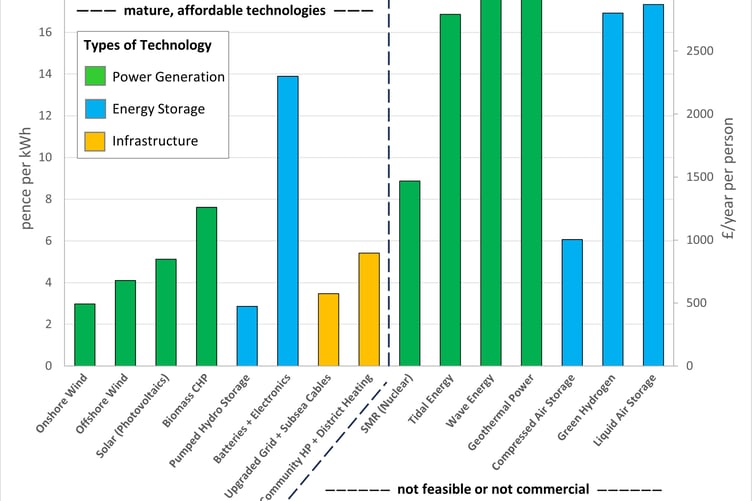Charity the Energy and Sustainability Centre IoM (ESC) calculate that the cost to Manx consumers of buying gas and oil is more than £200 million per year. Wouldn’t it be nice if we produced all the power we need ourselves, instead of having to import fuel or electricity at the mercy of fluctuating global energy prices?
This is an achievable goal if the island chooses the sources of energy and technologies best suited to our needs. Read on for the first of two articles from ESC (and click back next week for part two).
Wind and solar pros and cons
We have a number of options but costs will always play a large part in decisions.
Thanks to 50 years of investments in wind turbines and photovoltaic solar cells, these are the cheapest for generating electricity – the fuel is essentially free and the equipment is produced en masse in factories.
Nowadays these are the technologies countries turn to first. In the Isle of Man we have the luxury of being able to choose from a large number of sites – both onshore (for wind and solar) and offshore (for wind).
It is cheaper to build wind turbines on land but there is significantly more room in the sea around the Island so both onshore and offshore are likely to play their part.
Both have a visual impact – onshore wind turbines are smaller but then they are closer than offshore turbines.
Contrary to popular belief, the impact of wind turbines on birds is very low – cats, cars, windows and environmental change are the main threats to birds
One argument made against wind and solar developments is that we cannot afford to pay for them.
However, this is similar to saying the Gulf States cannot afford to drill for oil.
Rather than governments making the investments, it is normal practice for industry to develop energy resources on behalf of the nation, in return for a small share of the profit.
Experienced companies tend to be better at managing project costs and so, even though they calculate on making money themselves, it tends to be cheaper and quicker for everyone than if the public sector does it by itself.
The main issue with wind and solar energies is that their strength fluctuates with weather and daylight. As a consequence, the supply of generated electricity does not match demand.
This fluctuation can cause the frequency and voltage of the grid to become unstable, ultimately leading to a blackout if the issue is not dealt with.
This is the reason that Manx Utilities Authority is proposing to build only a relatively small amount of renewable energy in the island, relying instead on a subsea cable (an interconnector) to the UK to import most of the power.
This is actually quite an easy way to keep the grid stable but the issue with this strategy is that market prices for electricity can be high and are notoriously unpredictable. A more secure solution would be to install on-island energy storage so that surplus power can be stored for when it is needed.
Most islands are investing in two types of energy storage - batteries, to keep the local grid stable, and in facilities known as pumped hydro storage to match power supply to demand (click here for a short video which explains how pumped hydro storage works).
If the Isle of Man possessed sufficient energy storage, it would also profit by trading electricity with mainland UK and Ireland. When there is little wind or sun around the British Isles and electricity demand is high, the price of electricity can be astronomical. This is the opportunity to sell stored power for profit. In the opposite case, when there is an over-supply of renewable energy, electricity can be imported for next to nothing and stored for future sale.
What about tidal and wave power?
Tidal projects, typically located in estuaries and lagoons, use the in-flow and out-flow of large amounts of seawater to drive turbines.
Examples of such major schemes are Rance in France and Sihwa in South Korea but there are actually not many in the world due to huge upfront costs and environmental concerns.
Projects in Swansea and the Mersey have failed to progress and the Isle of Man has no obvious site for this sort of development.
Of more interest is the possibility of using tidal currents which flow through narrow marine channels, as such channels can be found around the Isle of Man.
The Orkney Islands are hosting some pilot projects to exploit this type of tidal energy, in addition to testing various technologies to utilise wave energy.
Unfortunately, none of the different tidal or wave technologies have reached a commercial stage but estimates are that the cost per unit of electricity is around five times that of wind (see graph).
It will therefore take some time before it makes strict financial sense to invest in tidal or wave power. Nonetheless, there may be some good publicity generated if the Isle of Man was to support a pilot project, helping a fledgling green industry on its way.
Look out for part two of this article soon in which we will examine the possibilities for nuclear power, bio-energy, geothermal energy and offshore gas and conclude with which technologies offer the best value for the Isle of Man.
Go to www.energysustainabilitycentre.im for more useful insights about renewable energy and sustainability – and find the latest news about ESC on its Facebook, Twitter and LinkedIn channels.





Comments
This article has no comments yet. Be the first to leave a comment.